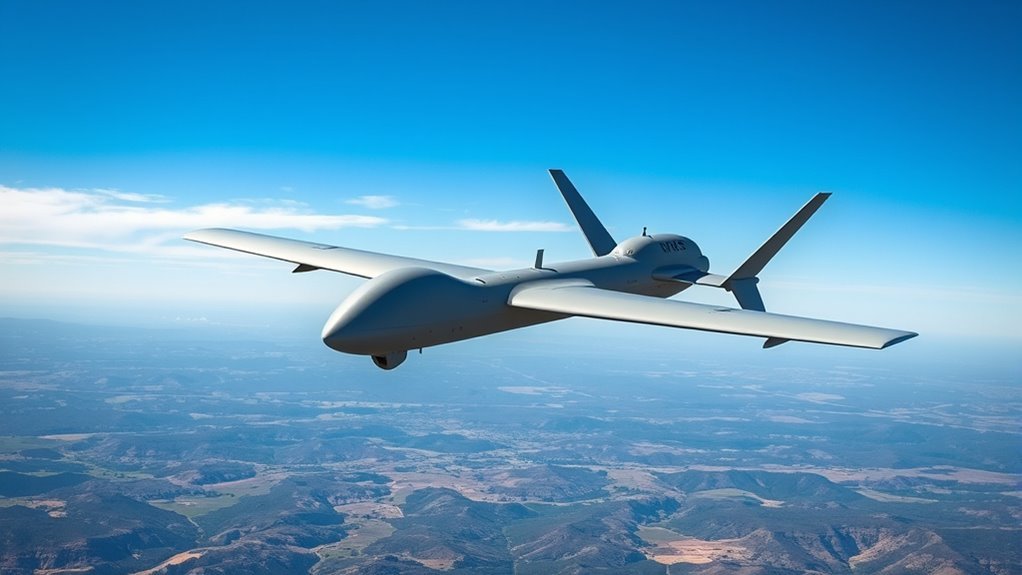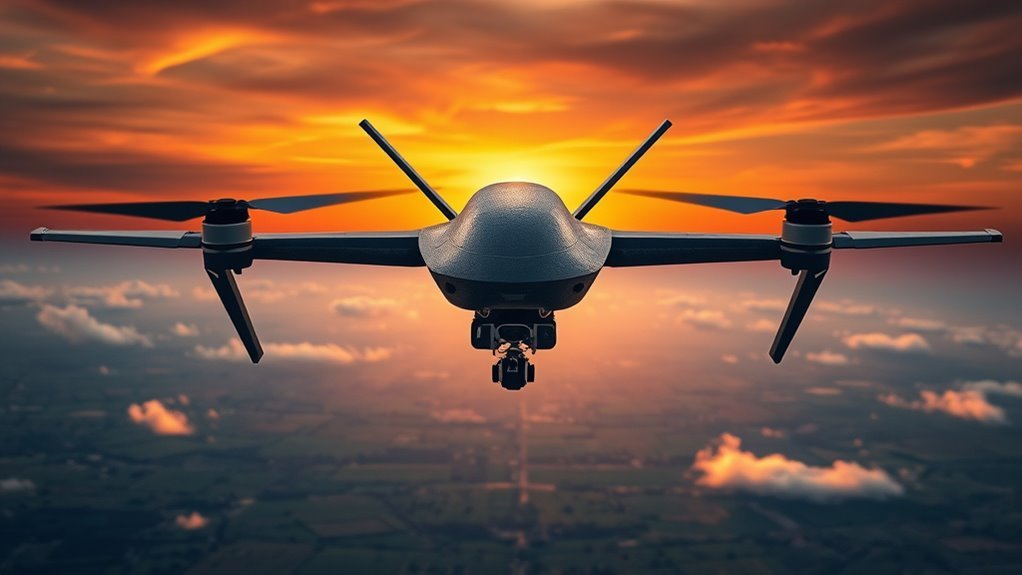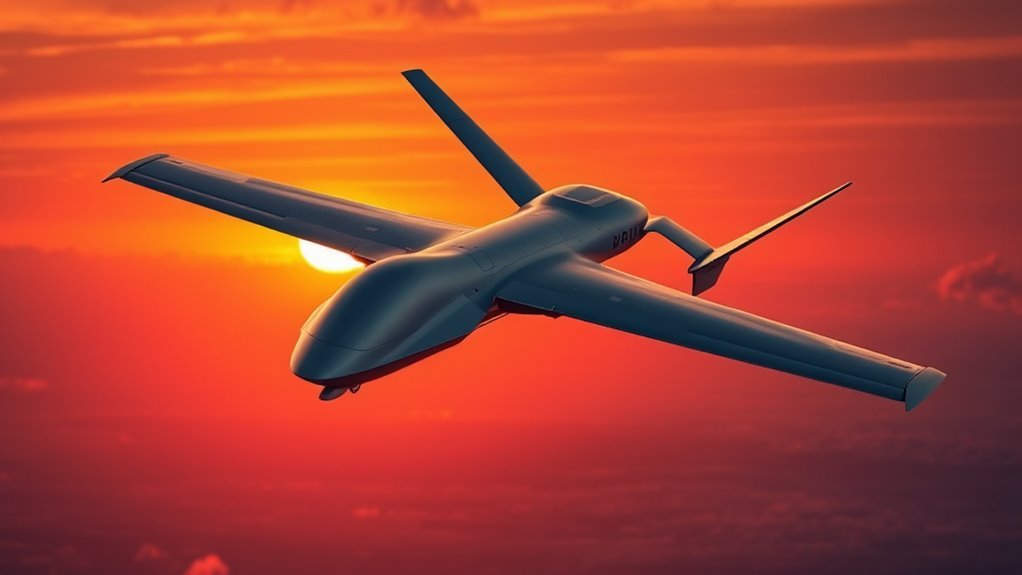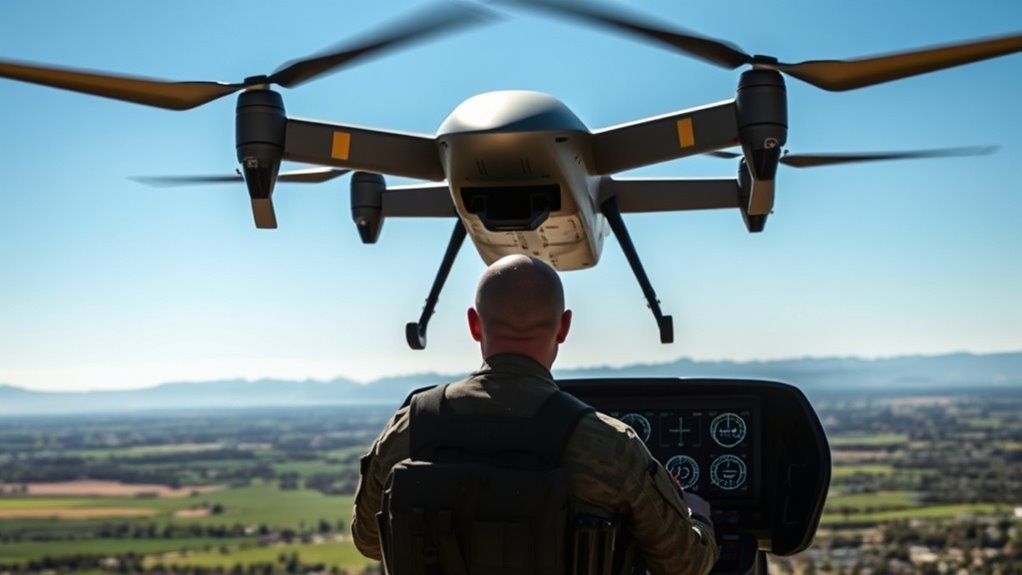The duration military drones stay in the air relies on several factors. Fuel capacity and efficiency directly influence range, while payload weight impacts performance. Aerodynamics, particularly wing configuration, plays a key role in lift and drag. Additionally, mission profiles dictate specific flight time requirements. Technological advancements, such as battery improvements and modular designs, enhance capabilities. Understanding these elements is essential for optimizing drone operations and mission effectiveness. You’ll find more insights on this topic ahead.
Fuel Capacity and Efficiency

Fuel capacity and efficiency are essential factors in determining a military drone’s operational range and endurance. You’ll find that the choice of fuel types directly influences engine efficiency, which in turn affects flight duration. Conventional fuels like JP-8 or alternative biofuels can be considered, each presenting distinct advantages and drawbacks. Higher energy density fuels enable longer missions but may require advanced engine designs to optimize performance. Additionally, the efficiency of the drone’s engine plays a crucial role; more efficient engines convert fuel into thrust with minimal waste. Consequently, a drone’s design must balance between fuel capacity and engine efficiency to maximize operational capabilities, ultimately ensuring that you can achieve mission objectives without unnecessary limitations on flight time.
Payload Weight and Design

While considering a military drone’s operational capabilities, payload weight and design play a fundamental role in determining its overall performance. The balance between carrying essential equipment and maintaining flight efficiency is critical. Effective payload optimization is essential; heavier payloads can reduce endurance considerably, impacting mission success. You must also consider weight distribution, as uneven loads can compromise stability and maneuverability. A well-designed drone will integrate advanced materials and configurations to minimize unnecessary weight while maximizing utility. By strategically selecting and distributing payloads, operators can extend flight durations and enhance operational effectiveness. Ultimately, understanding the interplay of payload weight and design is crucial for achieving the freedom and flexibility necessary in military operations. Additionally, the integration of advanced materials can significantly improve the drone’s overall performance. Moreover, a modular design allows for payload swapping, which enhances mission adaptability.
Aerodynamics and Wing Configuration

The relationship between payload and flight efficiency naturally leads to an examination of aerodynamics and wing configuration. The design of a drone’s wings greatly influences its lift generation and overall performance. By optimizing wing shape, you can enhance flight stability, maneuverability, and fuel efficiency, directly impacting how long the drone can stay airborne.
- The aspect ratio affects lift-to-drag ratio.
- Wing shape influences airflow and turbulence.
- Fixed wings offer better efficiency over longer distances.
- Wing area determines lift capacity.
- Control surfaces play a role in stability and responsiveness.
Understanding these factors helps you appreciate the intricate balance between payload, wing design, and flight duration, ultimately ensuring the drone achieves its operational potential.
Mission Profile and Operational Requirements
Understanding mission profiles and operational requirements is essential for optimizing military drone flight duration, as these factors dictate the specific capabilities needed for various missions. Each mission’s duration is influenced by its tactical demands, from reconnaissance to strike operations. You need to assess the operational tactics to determine how long a drone must remain airborne to achieve its objectives effectively. For instance, surveillance missions may require extended flight times, whereas targeted strikes might prioritize speed and precision over endurance. Additionally, environmental conditions and payload weight can greatly impact mission duration. By aligning drone capabilities with operational tactics, you can enhance efficiency, ensuring that each mission is executed within its required timeframe, maximizing both effectiveness and resource utilization in the field. Moreover, understanding advanced safety mechanisms can further enhance mission reliability and performance. The integration of high-resolution imaging technologies also plays a significant role in improving situational awareness during missions.
Technological Advancements in Drone Design
As military operations evolve, advancements in drone design play a crucial role in enhancing flight duration and overall mission effectiveness. Innovations in battery technology and flight control systems are at the forefront of these developments. You’ll find that these breakthroughs not only extend operational capabilities but also improve reliability and efficiency.
- Enhanced battery efficiency for longer flight times
- Advanced aerodynamics reducing drag and increasing range
- Real-time flight control algorithms optimizing performance
- Modular designs for quick upgrades and adaptability
- Lightweight materials improving payload capacity
These technological strides empower military forces, enabling them to conduct longer missions while maintaining strategic advantages, ultimately contributing to greater operational freedom and effectiveness in the field. Additionally, precision engineering within drone design ensures that every component functions reliably under demanding conditions. Moreover, AI algorithms enhance real-time data processing capabilities, allowing for more efficient navigation and operational autonomy.
Frequently Asked Questions
How Do Weather Conditions Affect Drone Flight Time?
Did you know that wind resistance can reduce a drone’s flight time by up to 30%? Temperature effects also play a role, impacting battery performance and overall efficiency, ultimately affecting how long you can stay airborne.
What Is the Average Lifespan of a Military Drone?
The average lifespan of a military drone varies greatly, influenced by drone technology and operational efficiency. Generally, you can expect around five to ten years, depending on maintenance, usage, and advancements in technology.
How Often Do Drones Require Maintenance?
You might think drone upkeep’s simple, but it’s not. Regular maintenance schedules are essential, often requiring checks every few weeks or months, ensuring ideal performance and longevity in the field while maintaining operational readiness.
What Regulations Impact Military Drone Flight Durations?
Flight regulations and operational protocols dictate drone missions, influencing endurance. You’ll find that adherence to these guidelines shapes flight durations, ensuring safety and compliance while balancing the need for operational freedom in military engagements.
Can Drones Be Refueled in Mid-Air?
Yes, mid-air refueling is possible with advanced drone technology, allowing for extended flight durations. This capability enhances operational flexibility, enabling drones to maintain consistent surveillance or strike capabilities without the need for frequent landings.

